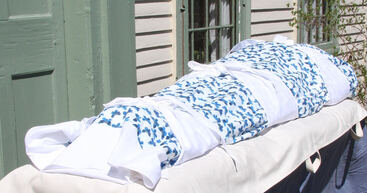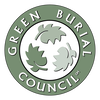 by Dina Stander What is a burial shroud? A burial shroud is a wrapping for a deceased being's body. We also call them winding sheets, grave clothes, cerecloth, Tahara, Kaffan. I have learned many words for shrouds since my first personal shrouding experience in childhood, when I wrapped a dead bird in leaves tied securely with long grass before burying it in the meadow. That instinct to protect the remains of the beloved, and to make the body easier to transport for disposition, has many cultural and historical expressions. From ancient art to fine art to photo montages of a modern day pandemic, we are not strangers to seeing images of shrouded bodies. Shrouding customs are practiced in significant world religions and cultures (widely by Hindus, Muslims, and Jews, in African communities, and by some Christian sects), each with its own rules and specifications. No one culture, group, or custom originated shrouding. It is a loving kindness that human beings have shared through collective memory over time. Why shrouds? The author Ray Bradbury wrote: "We are cups, constantly and quietly being filled. The trick is, knowing how to tip ourselves over and let the beautiful stuff out." Why did I wrap that little dead bird in leaves tied with grass when I was eight years old? No one taught me to do that, although I'm sure by then I'd seen burials in old cartoons and westerns on TV. When I tipped myself over in that Ray Bradbury way, a leaf shroud made from what was close at hand seemed like the most natural and sacred way to honor a life. I was a field and forest wandering kid. It never occurred to me to bury the bird in a box. In most shrouding cultures the shroud is a culminating facet of ritually washing and preparing the body for a journey to the chosen place of disposition, so that the spirit is free to journey as well. Shrouding allows us the time to honor the body of the person who has died and offers the comfort of protecting their body a last time, even as we release them to the disassembling elements of physical transition: time, soil, microbes, water, or fire. We know the shroud is a temporary cocoon, even as we know our loved one has died and that their body is now empty. The action of shrouding creates a chamber for the metamorphosis a body needs to become reduced again to the star stuff (science tells us) that all of creation is made from. How is a green burial shroud different? First off, it is cloth. Almost every burial shroud I have seen and touched has been essentially green. In green burial we carefully consider our choices for final disposition within the context of our ecological relationships, in life and in death. A burial shroud is generally made of textiles of some kind. In the fabric world, being genuinely green means gaining an understanding of the 'fibershed' we are a part of. As a thought experiment, start with the concept of a watershed, and then think cloth, and then meander from field to harvest, processing to production, and finally delivered into your hands for use. Creating a shroud used in green burial means we commit ourselves to thinking about where the fiber comes from, how it is grown, milled, woven, dyed, transported, marketed, used, reused, up-cycled, recycled, etc. The shroud is as important as anything else we put in the grave, because the remains of decomposition are being considered in the overall ecology of the burial site. Whether or not we are also using a coffin, less is more. Choosing to use less fabric and avoiding metal or plastic zippers and buttons are as relevant as any other embellishments and grave additions that will or will not eventually reduce to soil. When there is time to plan ahead for a green burial shroud, consider using organic fibers produced near to home, or sourcing a finished product or materials made from wool, cotton, hemp, or other natural fibers that are ecologically grown, dyed, woven, and sewn. If you are improvising with what you have on hand, lean into simplicity and choose to reuse the most natural fibers available to you (household silks and linen tablecloths will be just fine). Types of shrouds: Essentially, a burial shroud is one or more pieces of cloth used to wrap a deceased person. There are sewn shrouds, folded shrouds, multi-piece religious shrouds, elaborate silk shrouds, plain shrouds you can add art to, and shrouds made from your own grandpa's shirts. Some have cloth handles and carriers, some have a sleeve for a body board and some come with convenient baskets. Most will need lowering straps. You can buy the shrouds used by faith traditions from funeral and burial supply distributors in North America. You can also purchase shrouds (in a variety of styles and price points) made specifically for natural and green burial by artisans you will find online—try an Etsy search and online natural and green burial suppliers. Some shroud makers provide bespoke and custom work from your heirloom and family textiles. The Jewish Tahara and Muslim Kaffan are multi-piece shrouding garments and winding sheets, with differences based on the gender of the deceased person. There are exacting guidelines about who can participate in religious shrouding, the order of the ritual dressing, and arcane fastening customs. A little research will turn up illustrated specifications to give you an idea of what is involved with this style of shroud and the customs practiced. One important value these traditions hold in common is that the shrouding garments and fabrics should be plain and unadorned with no indication of the deceased person's material wealth in life, to show that in death we are equal in our humanity. And of course, you are a human being with ancient wisdom in your bones and you can make your own shroud. A homemade shroud doesn't need the finest seams. It is ok to use yarn and a giant needle and stitch it together in a tidy enough way. Those early humans who cocooned a beloved dead friend in leaves and mosses did not need a straight hem and neither will you. Use what you have available. Repurposed fabric is usually a green burial choice as long as the cloth is natural—not synthetic or embellished with metallic or plastic paints. Use your common sense, and if you are burying in a specifically green cemetery ask them for guidelines to follow. When I started researching burial shrouds ten years ago, I stumbled on a generous share of patterns for both unsewn and sewn shrouds on the website of the Canadian Integrative Network for Death Education and Alternatives (CINDEA). This site is still current and has the most straightforward DIY shroud-making information I have found online. How to shroud/wrap a body: All the different styles of shrouds on the market and for DIY will fill, fit, tie, and carry in different ways, so I suggest doing the research to find what matches your aesthetic, the body, the burial site, and your pocketbook. In shrouding cultures such as the observant Jewish and Muslim communities where ancient rituals and accumulated wisdom are handed down, the needs of the deceased are seen to deftly. There is an order to the ritual with specific garments and shroud pieces (sometimes gender specific), a particular way knots are tied, and prescribed prayers and songs. If you have origins in a shrouding culture or faith tradition I encourage you to find out how your people go about the work of preparing the dead for burial. There is so much to learn! The motions and gestures of shrouding are familiar to any one who has swaddled a baby—lifting and rolling, wrapping and tucking, and settling-in. But this sense memory is both helpful and strange in death and (assuming the deceased person is an adult) the physics are very different. For people approaching shrouding for the first time, it genuinely helps to practice with a living person 'playing dead' before you try this out in a time of need. And if you are in a time of need and are shrouding for the first time, because dead people are heavy and cannot assist you in any way, it still helps to practice first with the living. It will make you laugh too, which is good medicine when you are living with dying. For more practice you can host a post-pandemic shrouding circle and invite a death educator to offer your green burial friends and community a chance to get acquainted with shrouding. If you find yourself suddenly in the thick of things, with cloth to wrap and a body that needs wrapping, my best advice is:
Dina Stander is a poet, shroud-maker, and end-of-life navigator. She founded the Northeast Death Care Collaborative. She currently offers workshops on shrouding, creative grieving, and 'distanced' mourning. You can learn more about her work at www.dinastander.com. If you are thinking of a burial shroud sewn from your own heirloom textiles or articles of clothing then be in touch! Last Dance Shrouds welcomes collaborative projects .
Comments are closed.
|
Call for EntriesWe welcome original content with unique perspectives for the GBC Blog, preferably not previously published. The views and opinions expressed on the GBC Blog are those of the authors and do not necessarily reflect the official position or policies of the GBC. Submit entries by email Archives
February 2024
|
 RSS Feed
RSS Feed

